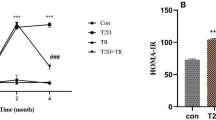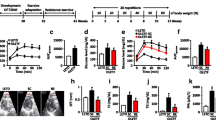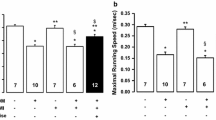Abstract
This study examined the effects of a dual treatment combining insulin treatment and exercise training on basal cardiac function and signaling pathways involving β3-AR, NOS1, and RyR2 in type 1 diabetic rats. Male Wistar rats were assigned into a diabetic group receiving no treatment (D), an insulin-treated diabetic (Ins), a trained diabetic (TD), and a trained insulin-treated diabetic (TIns) group. Control group (C) was included in order to confirm the deleterious effects of diabetes. Insulin treatment and/or treadmill exercise training were conducted for 8 weeks. Basal cardiac function was evaluated by Langendorff technique. Cardiac protein expression of β3-AR, NOS1, and RyR2 was assessed using Western blots. Diabetes induced a decrease of both basal diastolic and systolic (±dP/dt) cardiac function (P < 0.05). Moreover, diabetes was associated with an increase of β3-AR and NOS1 and a decrease of RyR2 expression (P < 0.05). Although combined treatment was not able to normalize –dP/dt, it succeeded to normalize +dP/dt of diabetic rats. Combined treatment led to an overexpression of RyR2. Effects of this combined treatment on +dP/dt and RyR2 were greater than the effects of insulin and exercise training, applied solely. Treatments, applied solely or in combination, resulted in a complete normalization of β3-AR and in a down-regulation of NOS1 because this protein expression in all treated diabetic rats became lower than control values (P < 0.01). Our study shows that unlike single treatments, dual treatment combining insulin treatment and exercise training was able to normalize basal systolic function of diabetic rats by a specific regulation of β3-AR–NOS1–RyR2 signaling pathways.





Similar content being viewed by others
References
Barnett AH (2006) Insulin glargine in the treatment of type 1 and type 2 diabetes. J Vasc Health Risk Manag 2(1):59–67
Rubler S, Dlugash J, Yuceoglu YZ, Kumral T, Branwood AW, Grishman A (1972) New type of cardiomyopathy associated with diabetic glomerulosclerosis. Am J Cardiol 30(6):595–602
Bell DS (1995) Diabetic cardiomyopathy. A unique entity or a complication of coronary artery disease? Diabetes Care 18(5):708–714
Amour J, Loyer X, Le Guen M, Mabrouk N, David JS, Camors E, Carusio N, Vivien B, Andriantsitohaina R, Heymes C, Riou B (2007) Altered contractile response due to increased beta3-adrenoceptor stimulation in diabetic cardiomyopathy: the role of nitric oxide synthase 1-derived nitric oxide. Anesthesiology 107(3):452–460
Bredt DS, Snyder SH (1994) Nitric oxide: a physiologic messenger molecule. Annu Rev Biochem 63:175–195
Massion PB, Balligand JL (2007) Relevance of nitric oxide for myocardial remodeling. Curr Heart Fail Rep 4(1):18–25
Ignarro LJ (2002) Nitric oxide as a unique signaling molecule in the vascular system: a historical overview. J Physiol Pharmacol 53(4 Pt 1):503–514
Hare JM (2003) Nitric oxide and excitation-contraction coupling. J Mol Cell Cardiol 35(7):719–729
Hare JM, Stamler JS (1999) NOS: modulator, not mediator of cardiac performance. Nat Med 5:273–274
Mery PF, Pavoine C, Belhassen L, Pecker F, Fischmeister R (1993) Nitric oxide regulates cardiac Ca2 + current. Involvement of cGMP-inhibited and cGMP-stimulated phosphodiesterases through guanylyl cyclise activity. J Biol Chem 268:26286–26295
Xu L, Eu JP, Meissner G, Stamler JS (1998) Activation of the cardiac calcium release channel (ryanodine receptor) by poly-S-nitrosylation. Science 279:234–237
Barouch LA, Harrison RW, Skaf MW, Rosas GO, Cappola TP, Kobeissi ZA, Hobai IA, Lemmon CA, Burnett AL, O’Rourke B, Rodriguez RE, Huang PL, Lima JAC, Berkowitz DE, Hare JM (2002) Nitric oxide regulates the heart by spatial confinement of nitric oxide synthase isoforms. Nature 416:337–340
Choi KM, Zhong Y, Hoit BD, Grupp IL, Hahn H, Dilly KW, Guatimosim S, Lederer WJ, Matlib MA (2002) Defective intracellular Ca2+ signalling contributes to cardiomyopathy in type 1 diabetic rats. Am J Physiol (Heart Circ Physiol) 283:H1398–H1408
Bidasee KR, Nallani K, Henry B, Dincer D, Besch HR (2003) Chronic diabetes alters function and expression of ryanodine receptor calcium-release channels in rat hearts. Mol Cell Biochem 249:113–123
Bendall JK, Damy T, Ratajczak P, Loyer X, Monceau V, Marty I, Milliez P, Robidel E, Marotte F, Samuel JL, Heymes C (2004) Role of myocardial neuronal nitric oxide synthase-derived nitric oxide in beta-adrenergic hyporesponsiveness after myocardial infarction-induced heart failure in rat. Circulation 110(16):2368–2375
Gonzalez DR, Beigi F, Treuer AV, Hare JM (2007) Deficient ryanodine receptor S-nitrosylation increases sarcoplasmic reticulum calcium leak and arrhythmogenesis in cardiomyocytes. Proc Natl Acad Sci USA 104(51):20612–20617
Flaim KE, Kochel PC, Kira Y, Kobayashi K, Fossel ET, Jefferson LS (1983) Insulin effects on protein synthesis are independent of glucose and energy metabolism. Am J Physiol 245:C133–C143
Fallow GD, Singh J (2004) The prevalence, type and severity of cardiovascular disease in diabetic and non-diabetic patients: a matched-paired retrospective analysis using coronary angiography as the diagnostic tool. Mol Cell Biochem 261(1–2):263–269
Acar G, Akcay A, Sokmen A, Ozkaya M, Guler E, Sokmen G, Kaya H, Nacar AB, Tuncer C (2009) Assessment of atrial electromechanical delay, diastolic functions, and left atrial mechanical functions in patients with type 1 diabetes mellitus. J Am Soc Echocardiogr 22(6):732–738
Gulve EA (2008) Exercise and glycemic control in diabetes: benefits, challenges, and adjustments to pharmacotherapy. Phys Ther 88(11):1297–1321
Bidasee KR, Zheng H, Shao CH, Parbhu SK, Rozanski GJ, Patel KP (2008) Exercise training initiated after the onset of diabetes preserves myocardial function: effects on expression of β-adrenoceptors. J Appl Physiol 105(3):907–914
Shao CH, Wehrens XH, Wyatt TA, Parbhu S, Rozanski GJ, Patel KP, Bidasee KR (2009) Exercise training during diabetes attenuates cardiac ryanodine receptor dysregulation. J Appl Physiol 106(4):1280–1292
Bidasee KR, Dincer ÜD, Besch HR (2001) Ryanodine receptor dysfunction in hearts of streptozotocin-induced diabetic rats. Mol Pharmacol 60(6):1356–1364
Zhong Y, Ahmed S, Grupp IL, Matlib MA (2001) Altered SR protein expression associated with contractile dysfunction in diabetic rats hearts. Am J Physiol (Heart and Circulatory Physiology) 281:H1137–H1147
Le Douairon Lahaye S, Gratas-Delamarche A, Malardé L, Carré F Rannou Bekono F (2010) 8 weeks of intense endurance training decrease β2-adrenoceptors in heart of diabetic rat. Sci Sports 25:153–156
Lemoine S, Granier P, Tiffoche C, Berthon PM, Rannou-Bekono F, Thieulant ML, Carré F, Delamarche P (2002) Effect of endurance training on oestrogen receptor alpha transcripts in rat skeletal muscle. Acta Physiol Scand 174(3):283–289
Barbier J, Rannou-Bekono F, Marchais J, Tanguy S, Carré F (2007) Alterations of beta3-AR expression and their myocardial functional effects in physiological model of chronic exercise-induced cardiac hypertrophy. Mol Cell Biochem 300(1–2):69–75
Lowry OH, Rosebrough NJ, Farr AL, Randall RJ (1951) Protein measurement with the Folin phenol reagent. J Biol Chem 193:265–275
Raev DC (1993) Evolution of cardiac changes in young insulin-dependent (type 1) diabetic patients-one more piece of the puzzle of diabetic cardiopathy. Clin Cardiol 16(11):784–790
Raev DC (1994) Which left ventricular function is impaired earlier in the evolution of diabetic cardiomyopathy. Diabetes Care 17(7):633–639
Mihm MJ, Seifert JL, Coyle CM, Bauer JA (2001) Diabetes related cardiomyopathy time dependent echocardiographic evaluation in an experimental rat model. Life Sci 69:527–542
DeBlieux PMC, Barbee RW, McDonough KH, Shepherd RE (1993) Exercise training improves cardiac performance in diabetic rats. Proc Soc Exp Biol Med 203(2):209–213
De Angelis KLD, Oliveira AR, Dall Ago P, Peixoto LRA, Gadonski G, Lacchini S, Fernandes TG, Erigoyen MC (2000) Effects of exercise training on autonomic and myocardial dysfunction in streptozotocin-diabetic rats. Braz J Med Biol Res 33:635–641
Netticadan T, Temsah RM, Kent A, Elimban V, Dhalla NS (2001) Depressed levels of Ca2+-cycling proteins may underlie sarcoplasmic reticulum dysfunction in the diabetic heart. Diabetes 50:2133–2138
Bidasee KR, Zhang Y, Shao CH, Wang M, Patel KP, Dinçer ÜD, Besch HR (2004) Diabetes increases formation of advanced glycation end products on sarco(endo)plasmic reticumum Ca2+-ATPase. Diabetes 53:463–473
Broderick TL, Poirier P, Gillis M (2005) Exercise training restores abnormal myocardial glucose utilization and cardiac function in diabetes. Diabetes Metab Res Rev 21:44–50
Loganathan R, Bilgen M, Al-Hafez B, Zhero SV, Alenezy MD, Smirnova IV (2007) Exercise training improves cardiac performance in diabetes: in vivo demonstration with quantitative cine-MRI analyses. J Appl Physiol 102:665–672
Ziolo MT, Bers DM (2003) The real estate of NOS signalling: location, location, location. Circ Res 92:1279–1281
Khan SA, Lee K, Minhas KM, Gonzalez DR, Raju SV, Tejani AD, Li D, Berkowitz DE, Hare JM (2004) Neuronal nitric oxide synthase negatively regulates xanthine oxidoreductase inhibition of cardiac excitation-contraction coupling. Proc Natl Acad Sci USA 101(45):15944–15948
Desco MC, Asensi M, Márquez R, Martínez-Valls J, Vento M, Pallardó FV, Sastre J, Viña J (2002) Xanthine oxidase is involved in free radical production in type 1 diabetes: protection by allopurinol. Diabetes 51(4):1118–1124
Acknowledgments
We gratefully thank Pr François Carré and Pr Eric Bellisant for their hospitality, and the Biostatistical PhD Audrey Lavenu for her statistical assistance, from the laboratory of Pharmacology (Faculty of Medicine, Rennes 1). We thank Mrs. Catherine Lemeslif and Christine Dutais from the laboratory of Medical Physiology (Faculty of Medicine, Rennes 1) for their technical assistance. We also thank Dawn C. Harrison and Will Loh (School of Clinical Sciences, University of Liverpool, UK) for their helpful advice for the English translation.
Conflict of interest
The authors declare that they have no conflict of interest.
Author information
Authors and Affiliations
Corresponding author
Rights and permissions
About this article
Cite this article
Le Douairon Lahaye, S., Rebillard, A., Zguira, M.S. et al. Effects of exercise training combined with insulin treatment on cardiac NOS1 signaling pathways in type 1 diabetic rats. Mol Cell Biochem 347, 53–62 (2011). https://doi.org/10.1007/s11010-010-0611-6
Received:
Accepted:
Published:
Issue Date:
DOI: https://doi.org/10.1007/s11010-010-0611-6




